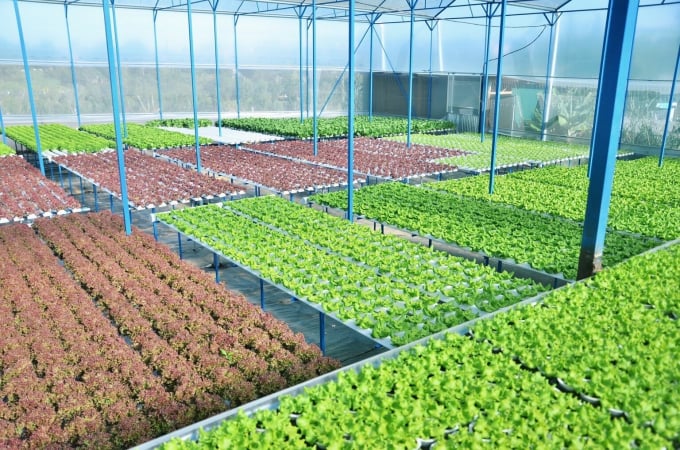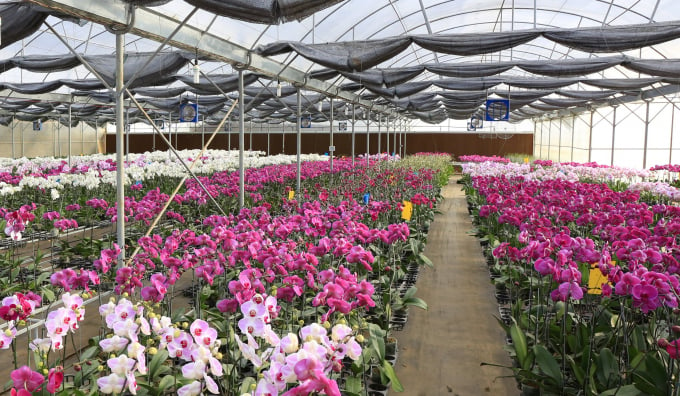May 21, 2025 | 08:27 GMT +7
May 21, 2025 | 08:27 GMT +7
Hotline: 0913.378.918
May 21, 2025 | 08:27 GMT +7
Hotline: 0913.378.918

Da Lat’s clean vegetables are grown in net houses.
According to statistics, the agricultural cultivation area in Lam Dong province is approximately 300,000 ha. The high-tech agricultural cultivation area alone is 61,160 ha, accounting for 20.3% of the total arable land. Lam Dong is currently is the country’s leading province in applying high technology to agricultural production.
To be more specific, the whole province currently has 235.5 ha installed automatic sensor systems for temperature, humidity, CO2, and smart nutrition management. Through the sensor system, the operator can acquire the most accurate information on crop conditions (pH, humidity, temperature, nutrition) to monitor and control irrigation and fertilization. The sensor network system is applied on sun-cutting nets and greenhouse roofs to optimize plant growth and reduce the amount of pesticides and fertilizers as well as labor used.
More than 2,500 ha growing vegetables, flowers and specialty plants apply automatic sprinkler irrigation technology. The province also applies sensor and automatic synchronization technology for 50ha of flowers and strawberries, automatic irrigation and fertilization systems for more than 2,827 ha of tea, and 4C, UTZ, Rainforest certified high technologies for 20,800ha of coffee. These figures show that Lam Dong possesses great potential for agricultural development in general and agricultural tourism in particular.
Realizing the uniqueness and high competitiveness of agrotourism, Lam Dong People's Committee has issued many policies, supports and encourages local people to develop this tourism model. With the additional support from JICA - Japan, the province has built the brand "Da Lat - Miraculous crystallization from good soil" which is used to promote images of agrotourism to domestic and foreign tourists.
The whole province currently has 33 certified agrotourism models to serve tourists and give them unique experiences, securing high economic efficiency. A number of models can be noted such as Green Box Coffee Model, Da Lach Noah, Long Dinh Tea, Vinh Tien Tea and Wine.
Tourists can learn about the crop’s automatic monitoring and care process, learn about humidity and light intensity in the greenhouse and how optimal adjustment should be, spectate a demonstration of the sprinkler/drip irrigation system, the light regulation system in action, all controlled through a phone or computer. The application of digital transformation is truly essential to creating a sustainable-value tourism chain along with many different options for tourists.
Thanks to applying digital transformation to provide information on locations, the province can create a network between tourist destinations, through which tourists can easily have the most suitable choice for their study trips, visits, or relaxation trips.
In addition to the province’s two official websites on tourism being operated (http://svhttdl.lamdong.gov.vn/ and http://dalat-info.vn/), Lam Dong province has developed a smart tourism system including the “http://dalat.vn” portal and a smart travel application called DaLatCity to serve tourists on mobile devices.
Thanks to this smart travel application tourists will be provided with official information regarding local tourism with pictures and interesting articles about the destination, or information on transportation, banking, healthcare, public toilets, weather. Especially tourists give out feedback on service quality or prices so that the authorities can promptly carry out adjustments.

Da Lat flowers are already considered “a valuable brand".
Lam Dong’s agrotourism has yet to make full use of the province’s potential and inherent strengths.
Many destinations providing agrotourism activities have difficulty connecting with tour operators to perfect agrotourism products as well as attract domestic and international tourists. Another issue is that agrotourism destinations are facing a shortage of human resources, especially those with high service skills and creativity, or they have laborers but the rate of training in tourism is low, unable to meet requirements, which results in a lack of personnel qualified in agrotourism management and facility operation.

Strawberries are grown in many places in Lam Dong.
In order for agrotourism products to develop in the coming time, it is necessary to meet novelty and modernity in the production process, productivity and quality of agrotourism products. A complete agrotourism promotion plan for each locality in the province which bases on the core value of agro-products and market demand is also required. Agrotourism branding needs to be invested wisely on the basis of regional characteristics, agricultural seasons and local products.
In addition, it is necessary to develop an agrotourism map and fully utilize modern information and communication technology applications to promote this tourism model. Signature agro-products should be associated with landmarks to have them introduced at forums, fairs and other promotional events.
The main subject of agricultural activities is the farmer, so in order to bring out the full potential of agrotourism activities, training on service skillsets and attitudes must be a top priority. A professional, skilled and friendly training program for local citizens will help create quality products and services that can attract more tourists in the future.
Translated by Samuel Pham

(VAN) Japan's grant aid project contributes to capacity building, promoting organic agricultural production, and fostering sustainable community development in Dong Thap province.

(VAN) For years, the CRISPR-Cas9 genome technology has been reshaping genetic engineering, a precision tool to transform everything from agriculture to medicine.

(VAN) Vietnam aims to become a 'leader' in the region in the capacity and managing effectively soil health and crop nutrition.
![Reducing emissions from rice fields: [Part 1] Farming clean rice together](https://t.ex-cdn.com/nongnghiepmoitruong.vn/608w/files/news/2025/05/05/z6509661417740_a647202949c539012a959e841c03e1d3-nongnghiep-143611.jpg)
(VAN) Growing clean rice helps reduce environmental pollution while increasing income, allowing farmers to feel secure in production and remain committed to their fields for the long term.
/2025/05/19/5136-1-144800_230.jpg)
(VAN) The Nghe An Provincial People's Committee has just approved the list of beneficiaries eligible for revenue from the Emission Reductions Payment Agreement (ERPA) in the North Central region for the year 2025.

(VAN) 14 out of 35 domesticated elephants in Dak Lak province have had their living conditions improved, with 11 of them currently participating in the non-riding elephant tourism model.

(VAN) Muong Nhe Nature Reserve hopes that being upgraded to a national park will lay the foundation for forest protection efforts to be carried out in a systematic, modern, and sustainable manner.